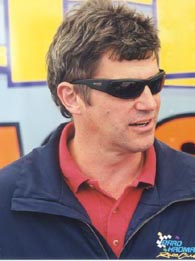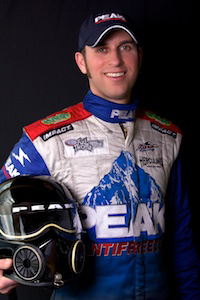HADMAN, LESSER FUNDED TEAMS TALK CANOPY
 Whether NHRA’s competition/rules committee will approve the innovative fully-enclosed canopy Tony Schumacher used in testing last month at Palm (Fla.) International Raceway is unknown.
Whether NHRA’s competition/rules committee will approve the innovative fully-enclosed canopy Tony Schumacher used in testing last month at Palm (Fla.) International Raceway is unknown.
However, Brad Hadman, a renowned chassis and car builder, believes NHRA would be making the Top Fuel dragster more dangerous for drivers because the fully-enclosed canopy adds about 25 pounds to a dragster’s weight.
“What NHRA is refusing to look at is these cars keep getting heavier and heavier,” Hadman said in an interview with Competition Plus. “They (NHRA) keep saying we are stressing the tire. Well, what stresses the tire? Weight. You are moving more mass faster than you ever have. So now they want to put 25 more pounds on it. It is insane to me. I think the safety issue of putting more weight on the car is greater than covering up the driver with a canopy. These cars are accelerating quicker to the eighth-mile than they ever have and they are what 200 pounds heavier than they were three or four years ago. The weight of that canopy is that much more mass that you have to move and it could push that tire over the edge and they chunk and you start blowing tires again.”
Heading into the 2012 season, NHRA Top Fuel cars are 25 feet long and weigh 2,250 pounds in race-ready trim.
Several NHRA Top Fuel dragsters use a Hadman chassis, including both Al-Anabi Racing dragsters, both Morgan Lucas Racing dragsters, Doug Kalitta, Steve Torrence, and Clay Millican among others.
 Whether NHRA’s competition/rules committee will approve the innovative fully-enclosed canopy Tony Schumacher used in testing last month at Palm (Fla.) International Raceway is unknown.
Whether NHRA’s competition/rules committee will approve the innovative fully-enclosed canopy Tony Schumacher used in testing last month at Palm (Fla.) International Raceway is unknown.
However, Brad Hadman, a renowned chassis and car builder, believes NHRA would be making the Top Fuel dragster more dangerous for drivers because the fully-enclosed canopy adds about 25 pounds to a dragster’s weight.
“What NHRA is refusing to look at is these cars keep getting heavier and heavier,” Hadman said in an interview with Competition Plus. “They (NHRA) keep saying we are stressing the tire. Well, what stresses the tire? Weight. You are moving more mass faster than you ever have. So now they want to put 25 more pounds on it. It is insane to me. I think the safety issue of putting more weight on the car is greater than covering up the driver with a canopy. These cars are accelerating quicker to the eighth-mile than they ever have and they are what 200 pounds heavier than they were three or four years ago. The weight of that canopy is that much more mass that you have to move and it could push that tire over the edge and they chunk and you start blowing tires again.”
Heading into the 2012 season, NHRA Top Fuel cars are 25 feet long and weigh 2,250 pounds in race-ready trim.
Several NHRA Top Fuel dragsters use a Hadman chassis, including both Al-Anabi Racing dragsters, both Morgan Lucas Racing dragsters, Doug Kalitta, Steve Torrence, and Clay Millican among others. Hadman formerly built Tony Schumacher's chassis before DSR began building their own chassis in-house last season.
Hadman also thinks the fully-enclosed canopy is more of a performance advantage than a safety measure.
“They (Don Schumacher Racing) are selling it as safety, but it is to benefit their aero package,” Hadman said. “I do not know anybody who has died because a piece is coming off and coming straight into the driver. They claim it is safety, but I do not buy that. Realistically, NHRA cars are probably some of the safest race cars. You look at an Indy car, you look at a F1 car, all of those cars are wide open to the driver. Ours (NHRA drivers) are inside a cage and the driver is really well protected. Racing is dangerous and they can say that canopy can save you, but you can die in that to.”
One concern is whether the NHRA, if it approves the fully-enclosed canopy, would mandate all teams to use it. Glen Gray, NHRA’s Vice President, Technical Operations addressed that issue with Competition Plus in an article published Friday.
“Going through this approval process right now, this first phase of it, if it was approved, we wouldn’t mandate it for the rest of the teams,” Gray said. “For the near term it would not be mandated, but we would have to re-evaluate that and think about it in the future.”
According to Gray, the canopy Tony Schumacher tested with at Palm Beach (Fla.) International Raceway Jan. 15-21 was built in conjunction with Don Schumacher Racing and Aerodine Composites.
Gray didn’t have any numbers in front of him in terms of the cost of the fully-enclosed canopy. Also, there is the issue if NHRA approves the canopy how easy will it be able to install on Top Fuel dragsters.
“I would think it (the fully-enclosed canopy) is probably a $15,000 investment,” said Hadma. “They claim it (the fully-enclosed canopy) will just bolt on (to a chassis) that it what Schumacher is telling everybody. I do not think the price would keep teams from using it (a fully-enclosed canopy), I think weight would.”
NHRA’s possible approval of the fully-enclosed canopy is something lower budget Top Fuel teams are monitoring.
“I think the canopy is really cool looking and it certainly adds a tremendous value of safety for the drivers,” said driver/team owner Terry McMillen. “I think some of the concerns could be like what happens if the car rolls over? There are some things I do not have answers to just because I have not talked to them yet, but I will do so in Pomona (at the Winternationals Feb. 9-12). I have some concerns, but I definitely think it is on the right track. I am extremely concerned about the financial side (of equipping his dragster with a fully-enclosed canopy) because I just do not know what it would cost to do that. I have heard numbers anywhere from $25,000 to $50,000. My life is certainly worth every bit of that. However, at some point in time I would have to cut that money from somewhere to be able to put that on there because I just do not have that kind of extra funding. That’s nobody’s problem but my own, I just have to do a better job of selling ourselves. But at this point and time if it (equipping drags
ters with fully-enclosed canopies) was a mandatory thing it would probably put me out of business for a little bit.” T.J. Zizzo, who drives a limited Top Fuel schedule in a dragster owned by his dad Tony Zizzo Sr., shared some of the same thoughts as McMillen.
T.J. Zizzo, who drives a limited Top Fuel schedule in a dragster owned by his dad Tony Zizzo Sr., shared some of the same thoughts as McMillen.
“The (fully-enclosed canopy) cockpits are cool, anything to make a dragster safer,” T.J. said. “I love going home to my wife and kids on Sunday night.”
T.J. also tackled the issue of the fully-enclosed canopy price tag and the added weight of the unit.
“What’s life worth?” T.J. said. “There is nothing inexpensive about campaigning a Top Fuel dragster. At more than $25,000 a pass that update would be minimal, amortized over the years the car is used. As far as weight goes, these cars are tanks anyway, what is another 25 pounds? I would like them to take it a step further and create a true pod car. I think McKinney was working on that years ago.”
Hadman hasn’t installed a fully-enclosed canopy on one of his chassis, but he doesn’t think equipping a fully-enclosed canopy on a dragster is that simple.
“Well, there are different size cars, so no,” Hadman said when asked if it would be realistic for the fully-enclosed canopy to easily be bolted on a dragster.
Hadman also believes if Don Schumacher wants to spend the money to build a fully-enclosed canopy to use then he should be able to.
“His car is just going to weigh 25 pounds more, I do not give a crap,” Hadman said. “But, do not say nothing to me when I do something. Innovation is what drives the sport, but all the innovation has gone away. They (NHRA) are controlling everything. If Don Schumacher wants to go put a canopy on his car, let him. Let him prove how valid his theory is. I can tell you where this is going. If they (NHRA) approve (the canopy) and you choose not to put that canopy on they (NHRA) are going to make you put 25 pounds on your car, and that is not right.”






































